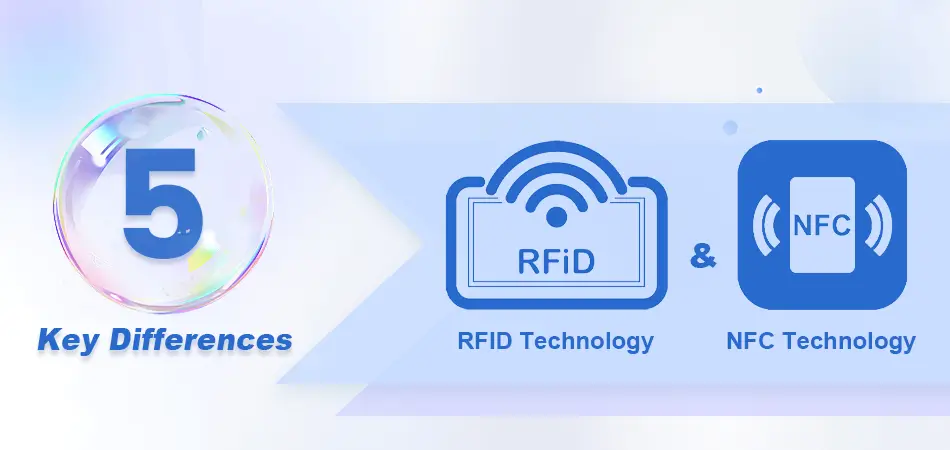RFID (Radio Frequency Identification) and NFC (Near Field Communication) technologies have been seamlessly integrated into our daily lives. While both RFID and NFC technologies utilize radio waves for communication, they serve different purposes and have distinct characteristics. Understanding the disparities between RFID and NFC is crucial, especially in fields like retail, logistics, and contactless payments.
When we choose to order technology products, we are often presented with a myriad of options and technologies to choose from. Sometimes all the abbreviations used in product features can be confusing.
RFID (Radio Frequency Identification): RFID is a technology that uses radio waves to wirelessly identify and track objects or individuals. It comprises RFID tags (containing a microchip and antenna), RFID readers (devices that read and write data to tags), and a backend system for managing collected data. RFID operates across different frequency bands (LF, HF, UHF) and finds applications in inventory management, supply chain tracking, access control, and more.
NFC (Near Field Communication): NFC is a short-range wireless communication technology that allows devices to communicate when held close together, typically within a few centimeters. NFC operates at 13.56 MHz and supports peer-to-peer, reader/writer, and card emulation modes. It facilitates activities like contactless payments, information sharing between devices, access control, and ticketing. NFC is commonly integrated into smartphones, tablets, and other consumer electronics.

RFID: RFID operates over a longer range compared to NFC, typically ranging from a few centimeters to several meters. This extended range makes RFID suitable for applications such as inventory management and asset tracking, where the ability to read tags from a distance is essential.
NFC: In contrast, NFC has a shorter communication range, typically limited to a few centimeters. This close proximity requirement is deliberate, as NFC is primarily designed for secure transactions and data exchange between devices held in close proximity.
RFID: RFID technology generally offers faster data transfer speeds compared to NFC. This advantage is particularly evident in scenarios where large volumes of data need to be exchanged swiftly, such as in supply chain management or access control systems.
NFC: While NFC may have slightly slower data transfer speeds compared to RFID, it excels in applications requiring secure and rapid transactions, such as contactless payments and ticketing systems.
RFID: RFID systems operate across a wide range of frequencies, including low frequency (LF), high frequency (HF), and ultra-high frequency (UHF). The choice of frequency depends on factors like communication range, data transfer speed, and interference levels.
NFC: NFC operates at a specific frequency of 13.56 MHz, falling within the HF range. This standardized frequency ensures interoperability between NFC-enabled devices, facilitating seamless communication and compatibility across various platforms.
RFID: While RFID systems offer security features such as encryption and password protection, they are generally considered less secure compared to NFC due to their longer communication range. This susceptibility to eavesdropping and data interception necessitates additional security measures in sensitive applications.
NFC: NFC technology prioritizes data security, employing robust encryption protocols and authentication mechanisms to safeguard sensitive information during transactions. The short-range nature of NFC communication adds an extra layer of security, reducing the risk of unauthorized access or interception.
RFID: RFID technology finds widespread applications across various industries, including retail, healthcare, transportation, and manufacturing. Its versatility and scalability make it suitable for diverse use cases, ranging from tracking inventory in retail stores to managing patient records in hospitals.
NFC: While NFC shares some application domains with RFID, its primary focus lies in contactless payments, mobile device pairing, and information sharing between smartphones and other NFC-enabled gadgets. NFC's seamless integration with mobile devices has led to its adoption in areas such as mobile payments, access control, and interactive marketing campaigns.
In conclusion, while RFID and NFC both harness the power of radio frequency for communication, they serve distinct purposes and exhibit notable differences in terms of range, speed, frequency, security, and application diversity. Understanding these disparities is essential for businesses and consumers alike, as it enables informed decision-making regarding the selection and deployment of these technologies in various contexts. Whether it's tracking inventory, facilitating secure transactions, or enhancing user experiences, choosing the right technology—be it RFID or NFC—can significantly impact efficiency, security, and overall success in today's interconnected world.
-------------------
Welcome to contact us!
RFIDSilicone is Your Best RFID & NFC Partner!
19+ years experience in RFID products (RFID wristband, RFID sticker/tag, RFID card etc).
Our own factory passed ISO9001: 2015 & ISO14001:2015. We have SGS, ROHS, REACH, FDA certificates etc.